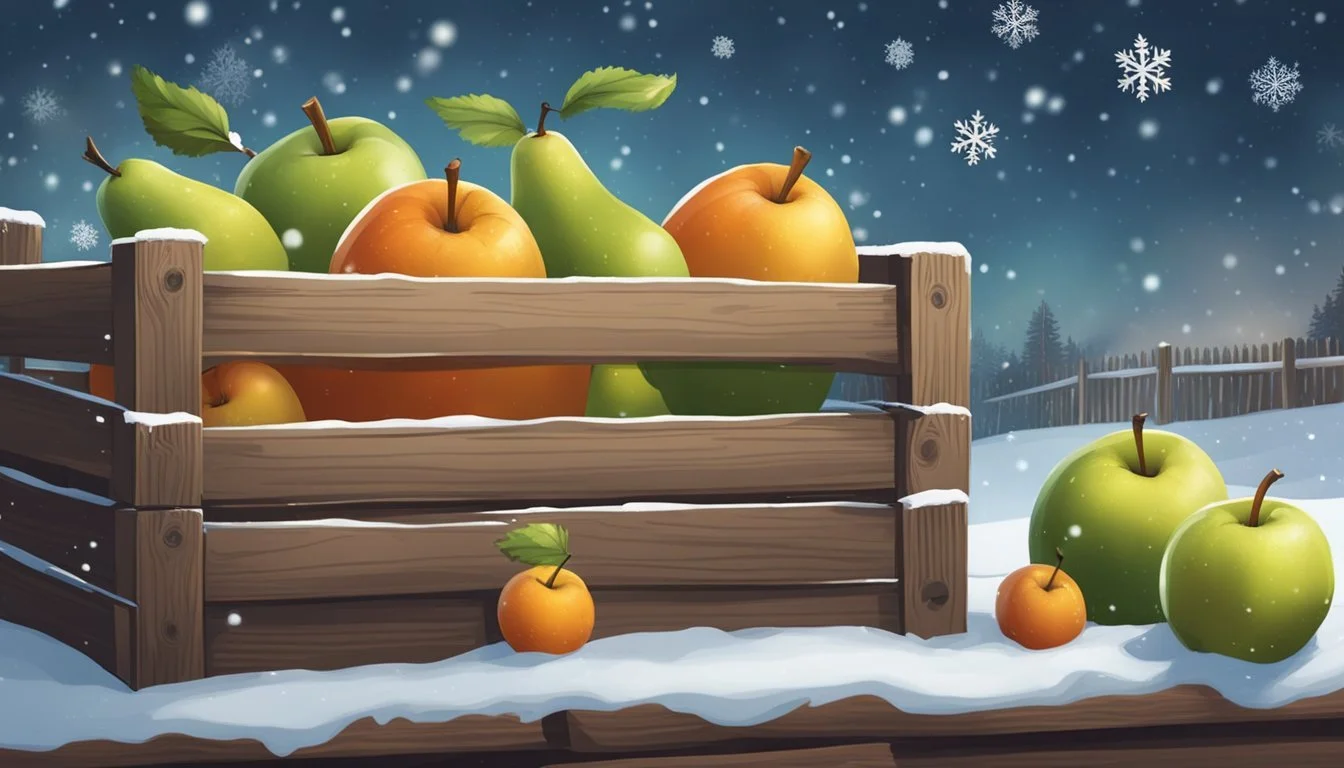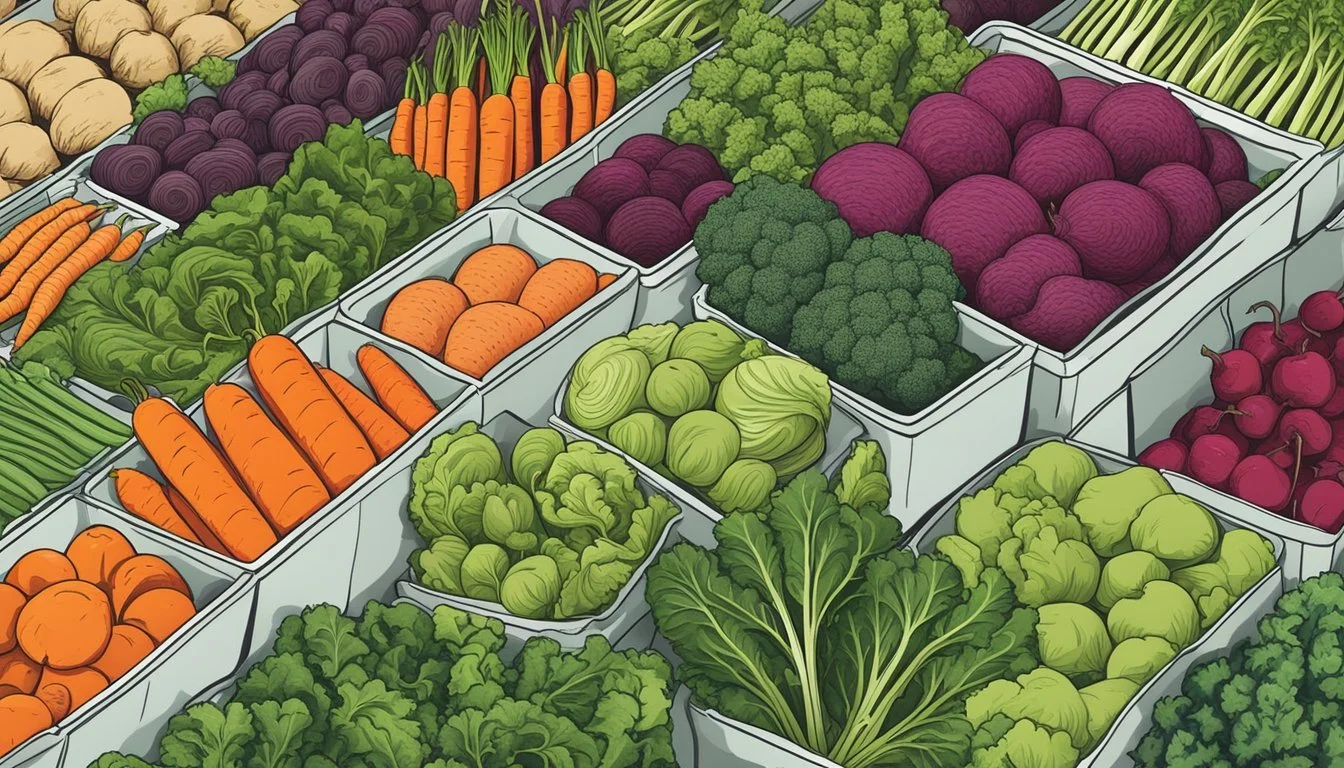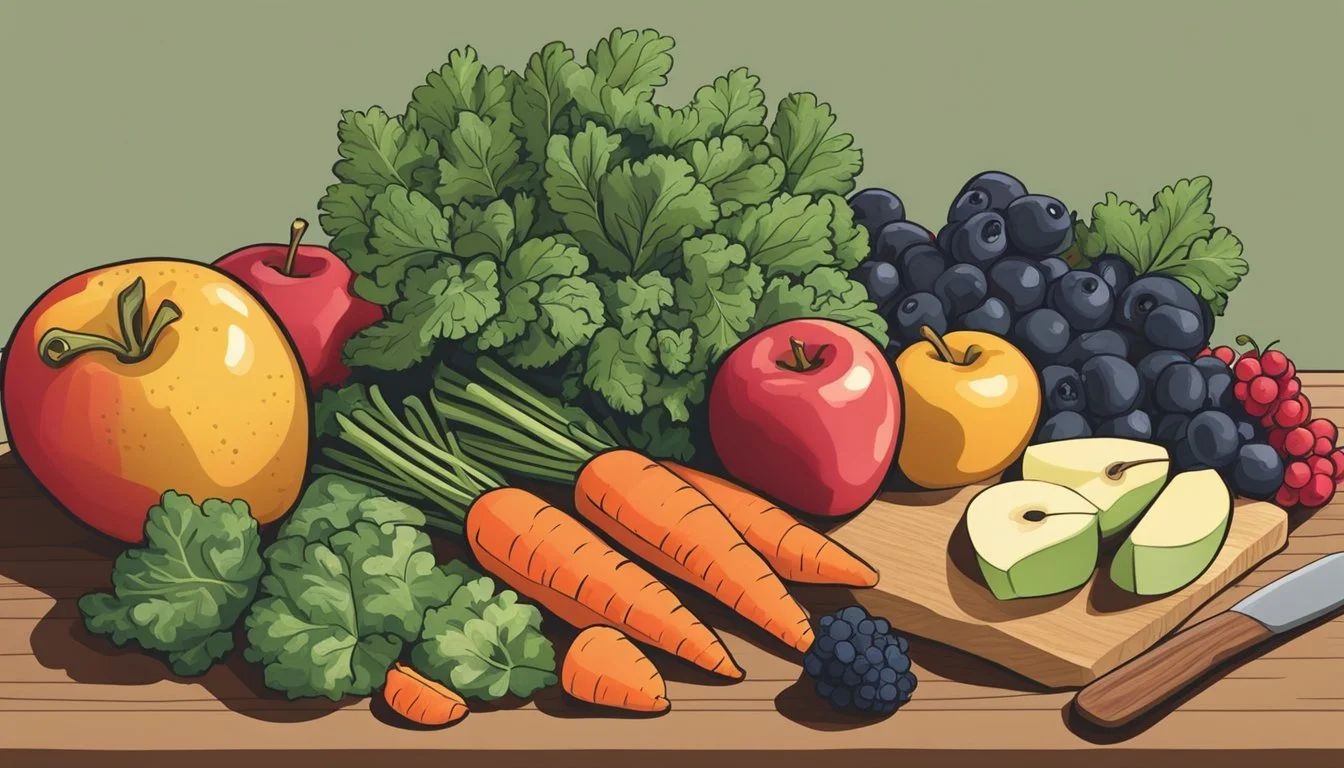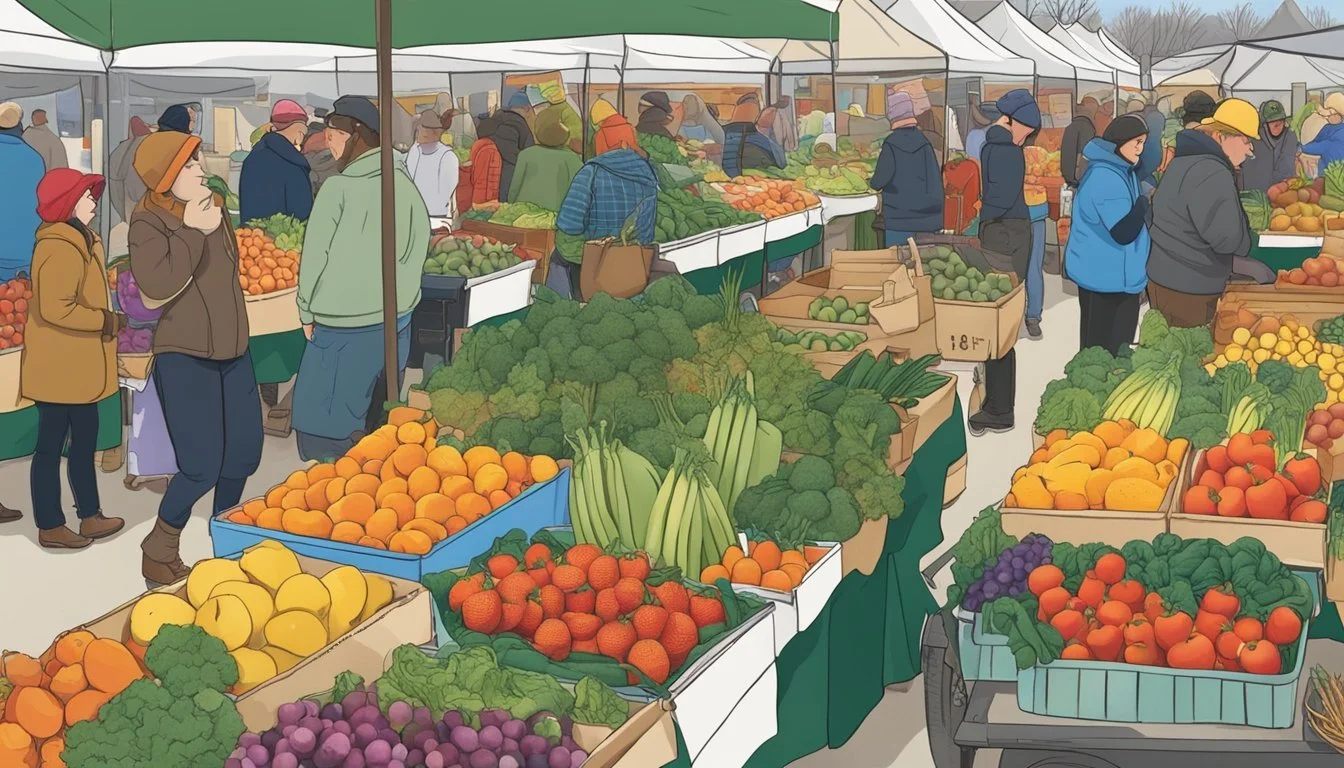Michigan Seasonal Fruit & Vegetables in March
Your Guide to Fresh Produce
This Article is Part of our Michigan Seasonal Fruit & Veg Calendar
Michigan's seasonal offerings of fruit (What wine goes well with fruits?) and vegetables in March are a testament to the state's diverse agricultural capabilities, despite the tail end of winter's chill. Consumers looking for fresh produce during this month have a variety of options that are not only flavorful but also supportive of local farmers and economies. As spring approaches, the state's produce begins to shift from storage crops to the first signs of new growth.
Vegetables like broccoli (how long does broccoli last?) and cabbage that thrive in cooler weather can be found in abundance, showcasing their versatility and nutrient density. On the cusp of spring, these vegetables are often harvested from hoop houses and cold frames, which provide a microclimate for produce to grow before the last frost. This guide serves as an invaluable resource for those aiming to incorporate seasonal vegetables into their diets during early spring in Michigan.
While fruit selections are more limited during this time of the year, Michiganders can still enjoy the last of preserved fruits or opt for cold storage apples and pears. As the weather warms, the state prepares for the arrival of early fruit varieties, setting the stage for a year-round cycle of fresh, local produce. The focus at this time is on nutritious and hearty vegetables that can withstand the transitional period between winter and spring.
Seasonal Overview
The seasonal availability of fruits and vegetables in Michigan during March is influenced by local weather patterns and the state's agricultural cycles. Consumers seeking fresh, in-season produce will find March offerings to be leaner than summer months, yet there are still quality options available.
Weather Influence
March in Michigan is characterized by the transition from the cold of winter to the tentative thawing of early spring. Weather in this state plays a significant role in determining the availability of produce. Although the temperatures can vary, the typically cold climate limits the growth of many fruits and vegetables.
In season: Limited varieties due to frost-sensitive crops still being out of season.
Seasonal Cycles
Michigan's seasonal cycles dictate that March is not a peak time for most produce. However, greenhouse farming and storage of root vegetables can supplement fresh options. Consumers can often find:
Root vegetables: Stored from the fall harvest.
Leafy greens: First harvests beginning, depending on greenhouse operations within the state.
Storage and greenhouse technology help to ensure that even in the off-peak, a selection of seasonal produce is maintained for local consumption. The guide to March availability showcases roots and greens over summer fruits.
Fruits in Season
In March, Michigan's climate limits the variety of local fruits available, but certain stored tree fruits from the previous season's harvest may still be found at markets, offering freshness and flavor.
Tree Fruits
While fresh tree fruits like apples and Asian pears are not typically harvested during March, stored varieties are commonly available and maintain quality. One can find selections such as:
Apples: Cold storage allows various apple varieties to be available. The flavor remains robust, suitable for both eating raw and culinary uses.
Asian Pears: Known for their crisp texture, these pears from the previous season can still be enjoyed for their subtle sweetness.
Berries
March is not peak season for Michigan berries, such as blueberries, blackberries, raspberries, and cherries (how long do cherries last?). Most berries are not yet available fresh in markets; however:
Cherries: Frozen or preserved cherries from the previous year's harvest may still offer a taste of Michigan's fruit bounty and are often sold at local farmers markets.
Vegetables in Season
March in Michigan marks the beginning of spring, and with it comes the budding of early-season vegetables. The cooler temperatures are still suitable for the last harvests of certain winter vegetables as well as the planting of early spring varieties. Consumers seeking fresh, vibrant flavors will find them at local farmers' markets.
Leafy Greens
In March, leafy greens such as spinach (What wine goes well with spinach?) and kale are resurging after their winter lull, ready to be picked. These greens are not only versatile in a culinary sense but also packed with essential nutrients. Michigan's farmers' markets begin to showcase these tender leaves, offering a fresh option for salads and cooked dishes.
Root Vegetables
Root vegetables like sweet potatoes and potatoes are reaching the end of their storage life, but are still available. They retain their earthy flavors and are a staple for hearty meals. One can often find these robust vegetables at their local markets, still within the window of optimal freshness.
Pod Crops
While the traditional pod crop season is not yet in full swing, some farmers may be offering early harvests of peas. These peas, though perhaps not as abundant as they will be in late spring and early summer, provide a hint of the sweet flavor that will soon be plentiful.
Michigan's vegetable selection in March provides a transition from the hearty produce of winter to the fresh beginnings that warm weather brings.
Harvest Calendar
March in Michigan signals the start of the spring produce season. This month introduces a variety of fresh crops that become available for harvest.
Monthly Guide to Produce
In March, individuals can look forward to a selection of vegetables that thrive in the cooler weather. Broccoli and cabbage are among the primary vegetables that reach maturity in mid to late March. They offer crispness and freshness, indicating the shift away from winter storage crops. The window for these vegetables extends into April, allowing for a period of continuous harvest.
Although the ground may still be cold, the cultivation of certain crops is well underway, such as greens. Various types of greens, including spinach and kale, start their season in April, yet some hearty varieties are available from local Michigan farms as early as March, providing fresh and nutritious options for early spring.
Herbs are also a highlight in the March harvest calendar in Michigan. As the ground thaws, farmers often have cold-hardy herbs such as parsley and chives (how long do chives last?) ready to enhance the flavors of seasonal dishes.
Throughout March, the availability of these crops not only marks the beginning of the seasonal cycle in Michigan but also reflects the region's agricultural adaptability. The month's produce offers a blend of the last of the winter harvest and the onset of fresh, spring selections, celebrating the state's rich farming landscape.
Shopping for Produce
When purchasing produce in Michigan during March, consumers have the option to visit farmers' markets or grocery stores. Both venues offer distinct experiences with an emphasis on freshness and supporting local agriculture.
Farmers' Markets
Farmers' markets provide a platform for local farmers to sell directly to the public. In March, shoppers can expect seasonal vegetables like broccoli and cabbage, which are coming into season. Visiting a farmers' market not only ensures access to fresh and locally-grown produce but also contributes to the local economy and community.
Benefits of shopping at Farmers' Markets:
Freshness: Produce is often harvested the same day or the day before.
Local: Directly supports Michigan farmers.
Grocery Stores
Grocery stores, on the other hand, might offer a wider variety of produce, including those not in season locally, due to their supply chains. The freshness may not equate to that of a farmers' market, but grocery stores provide convenience and consistency in availability.
Benefits of shopping at Grocery Stores:
Variety: A broader range of fruits and vegetables, including non-local options.
Accessibility: Predictable hours and locations.
It is important for consumers to inquire about the origin of produce to ensure they are making informed decisions and supporting local agriculture when possible.
Preparation and Recipes
March in Michigan heralds the season for a variety of fresh and flavorful fruits and vegetables. Avid cooks and food enthusiasts can bring out the best in these seasonal produce by employing appropriate storage methods and experimenting with diverse cooking techniques.
Storage Tips
Proper storage not only extends the shelf life of fresh produce but also maintains its nutritional value and taste. Here are some tips for common March produce:
Broccoli and Brussels Sprouts: Store them unwashed in loose or perforated bags in the crisper drawer of the refrigerator.
Carrots: Keep carrots in the coolest part of the refrigerator wrapped in a moist towel or in a plastic bag with holes.
Citrus Fruits: Citrus can be left on a counter for a few days, but for longer storage, place them in a fridge drawer.
Spinach: Place spinach in a plastic bag with air holes and store in the crisper to retain freshness.
Artichokes (What wine goes well with artichokes?): Store in a plastic bag in the refrigerator with a few drops of water to keep them hydrated.
Note: Always remove any tight bands from your vegetables or they will spoil faster.
Cooking Suggestions
Turning seasonal produce into delectable dishes requires both creative and traditional cooking methods:
Roasted Vegetables: Toss Brussels sprouts or carrots with olive oil and your choice of herbs. Roast until tender to bring out their natural sweetness.
Citrus Salads: Brighten up salads with fresh citrus segments for a refreshing contrast in flavor.
Steamed Artichokes: Steam and serve with a butter or garlic sauce. Artichokes' tender hearts are also excellent when roasted.
Spinach Salads: Fresh spinach makes for nutrient-rich salads. Pair with a light vinaigrette to complement its flavor.
Citrus-Infused Baked Goods: Use the zest and juice of citrus fruits to infuse cakes and cookies with a fresh, tangy flavor.
Farmers' markets in Michigan are great spots to find the freshest march produce and to seek advice from local growers on the best ways to prepare and cook their offerings.
Supporting Local Agriculture
In Michigan, supporting local agriculture particularly enriches the community and bolsters the state’s economy. When individuals purchase directly from local farms, they contribute to the sustenance of farming operations and the preservation of regional food systems.
Community Involvement
Community members in Michigan can engage with local agriculture by visiting farmers' markets and participating in seasonal events that promote local produce. They may also connect with farmers through community-supported agriculture (CSA) programs, where they subscribe to receive a regular share of the harvest. Sharing information about these markets and events through community Facebook pages and other social media can further enhance local support. The more consumers engage with these avenues, the more they contribute to a vibrant local farming community.
Ways to get involved:
Visiting local farmers' markets
Joining a CSA program
Advocating for local farmers on social media
Farm to Table Initiatives
"Farm to Table" initiatives are crucial in creating a bridge between Michigan farmers and consumers. These programs ensure that the fruits, vegetables, and other products grown on Michigan farms make it directly to local tables. Restaurants, schools, and other institutions often work closely with local farms, featuring seasonal specialties and supporting the state’s agricultural diversity. Consumers can support these initiatives by choosing establishments that prioritize sourcing from Michigan farms. Additionally, consumers can usually find contact details such as a phone number or website for these farms, enabling direct inquiries and purchases.
Direct support opportunities:
Dining at restaurants that source locally
Supporting educational programs that include local produce
Buying directly from farm websites or contacting them via phone
By engaging in community involvement and farm to table initiatives, Michiganders can actively contribute to the support and growth of local agriculture.
Seasonal Eating and Health
Eating seasonally is beneficial for one's nutrition and well-being. In March, Michigan's seasonal produce begins to vary, offering fresh options for a balanced diet. Freshness is a key component of nutrition because the shorter the time between harvest and consumption, the less nutritional degradation occurs.
Local produce, like broccoli and cabbage, which starts to become available at the end of March, often has a higher nutritional value compared to their out-of-season counterparts. Locally sourced vegetables that haven't traveled long distances retain more of their vitamins and minerals.
Flavor also plays a significant role in the appeal of seasonal eating. Fresh, in-season produce, such as leafy greens and the first herbs of spring, not only taste better but are more likely to be consumed in their entirety, minimizing waste and maximizing nutrient intake.
Health Benefits of Seasonal Produce in March:
Broccoli:
High in vitamin C and K.
Contains potent antioxidants.
Cabbage:
Rich source of vitamin C.
High in fiber, supporting digestive health.
Eating seasonal produce supports the local economy and ensures one is getting the most flavorful and nutritionally rich foods available. Integrating these foods into a diet can enhance the taste of meals, such as salads, and can bolster well-being by supplying essential nutrients.
By focusing on seasonal, local produce, individuals are more likely to enjoy meals that are not only nutritious but also contribute to sustainable food practices.
Further Resources
For those seeking comprehensive details on Michigan's seasonal fruits and vegetables in March, a variety of specialized websites and apps offer in-depth information, market locations, and availability guides. Additionally, cookbooks and guides tailored to Michigan's produce can enrich one's selection and culinary use of local, in-season produce.
Websites and Apps
A number of digital resources are available:
Michigan Fresh - College of Agriculture and Natural Resources: Users can leverage their location or a provided ZIP code to discover market and farm locations in their area, check the availability of seasonal produce, and obtain market details such as websites, phone numbers, addresses, and operational hours.
Market Maker: A platform connecting markets and consumers, providing a wealth of information on seasonal availability and local providers.
Michigan Produce Availability Chart: An offering from the Center for Regional Food Systems, which presents a mobile-friendly chart to track the presence of regional produce throughout the year.
Cookbooks and Guides
For enthusiasts seeking tangible resources:
Regional Cookbooks: These often include a variety of recipes and tips that emphasize the use of Michigan's seasonal produce for the month of March.
Seasonal Availability Guides: These guides list fruits and vegetables that are locally available, enhancing one's grocery selection and aiding in menu planning. They can typically be found at local bookstores, farmers markets, or can be downloaded from official websites of Michigan's agricultural departments.









